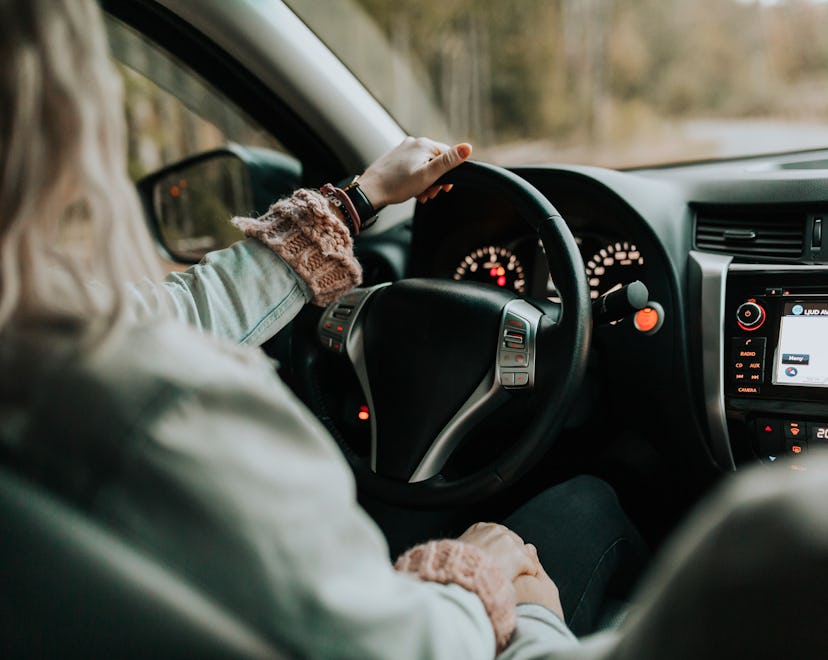Postpartum

Here’s When Doctors Say Say It’s Safe To Drive After A C-Section
You might need to put your car keys down for a little while.
You’re a mobile momma, and as such, you’re used to being on the go at all times. But after you have a cesarean section procedure, you might find that your mobility is majorly limited. Still, pediatric appointments and Target runs can’t wait, so you’ll need to get behind the wheel at some point or another. But if you’ve got your car keys in hand and you’re wondering when you can drive after a C-section, you might want to hit the brakes on your plans.
When can I drive after a C-section?
Before can start driving after a C-section, it’s best to wait a while, Dr. David M. Kimble, M.D., a board-certified urogynecologist at The Kimble Center tells Romper. “Traditional teaching always stated you should wait two weeks before driving,” says Dr. Kimble. “However, this can be unrealistic for busy or single moms. Thus, in my practice I inform patients they can start driving when they stop pain medication and are experiencing very little pain.” Now, this could be as soon as a few days after surgery, or even longer, depending on how your postpartum recovery is going.
Why do you have to wait to drive after a C-section?
Sure, you’re still healing from having major surgery, and you’re probably not sleeping more than a few hours at a stretch, thanks to your newborn. But you still need to know when you can start driving after a C-section. Interestingly enough, it’s not the pressure of the seatbelt on your incision that’s the potential problem, Dr. Cheruba Prabakar, M.D., an OB-GYN, tells Romper. “The real issue is that you can’t be on narcotics for pain and driving,” she says. “You have to be able to safely perform the actions of driving, and narcotics can impair that.” Researchers found that, indeed, painkillers (which are classified as opioids), can impair driving-related functions, according to a PubMed study.
In addition to having a sound mind, you have to be able to, well, drive. “The concern is directly related to experiencing pain when moving your leg and foot from the accelerator to the brake,” explains Kimble. “Pain may cause a delay in this movement resulting in a higher chance for an accident.” You can always use a soft pillow in between your lap belt and your incision (whether you’re the passenger or the driver) so that your incision is cushioned.
How to drive safely after a C-section
Manage your pain
There might be moments when you don’t have a friend or family member who can do a supermarket sweep for you. If you do need to drive, you can do so safely, but with some precautions. “Take a non-narcotic medication in advance of driving such as Ibuprofen or Tylenol,” suggests Kimble. “You can also use a lap pillow, travel back roads at a slower speed, and allow greater distance than usual from the vehicle in front of you.”
Use the buddy system
Additionally, advises Prabakar: “You should take someone with you for the first week that you’re driving to avoid being alone if possible,” she says. “Also, try doing practice runs down your street so that you’re prepared for how it feels to drive again.”
What potential complications should you be concerned about if you’re driving after a C-section?
It’s not so much the belt you have to worry about, but your mental acuity. “Lightheadedness, dizziness, feeling foggy and lack of sleep are the major risk factors for driving after a C-section,” says Prabakar. “If you feel any of these symptoms, you shouldn’t be driving.” But there are physical symptoms you should be aware of as well. “You should note any continued pain, bleeding from the incision, drainage and swelling of the incision,” advises Kimble. “If any of the above occur and remain persistent, then contacting your doctor is imperative. If the incision has any areas of separation, then this can be corrected in the office usually with steri-strips.”
Driving after a C-section is something that will depend greatly on how you feel, both physically and mentally. If you’re able to shift gears without crossing your eyes in pain, and are clearheaded enough to concentrate, you’ll be back on the road in no time.
Study cited:
Cameron-Burr, K., Conicella, A., Neavyn, M. “Opioid Use and Driving Performance” 2021.
Experts:
Dr. David M. Kimble, M.D., a board-certified urogynecologist at The Kimble Center
Dr. Cheruba Prabakar, M.D., an OB-GYN